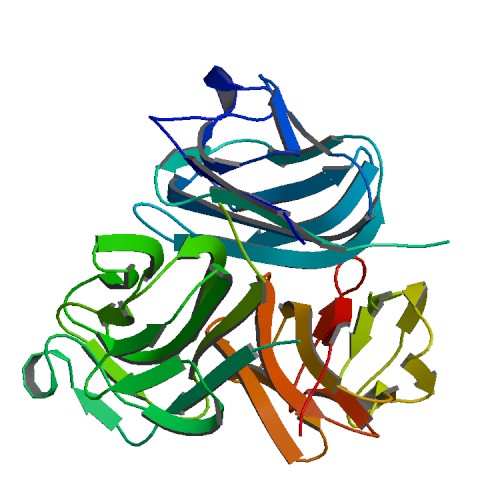EDA (gene)
 From Wikidoc - Reading time: 5 min
From Wikidoc - Reading time: 5 min
| Ectodysplasin A | |||||||||||||
|---|---|---|---|---|---|---|---|---|---|---|---|---|---|
 PDB rendering based on 1rj7. | |||||||||||||
| |||||||||||||
| Identifiers | |||||||||||||
| Symbols | EDA ; ED1; ED1-A1; ED1-A2; EDA1; EDA2; HED; XHED; XLHED | ||||||||||||
| External IDs | Template:OMIM5 Template:MGI HomoloGene: 68180 | ||||||||||||
| RNA expression pattern | |||||||||||||
 | |||||||||||||
| More reference expression data | |||||||||||||
| Orthologs | |||||||||||||
| Template:GNF Ortholog box | |||||||||||||
| Species | Human | Mouse | |||||||||||
| Entrez | n/a | n/a | |||||||||||
| Ensembl | n/a | n/a | |||||||||||
| UniProt | n/a | n/a | |||||||||||
| RefSeq (mRNA) | n/a | n/a | |||||||||||
| RefSeq (protein) | n/a | n/a | |||||||||||
| Location (UCSC) | n/a | n/a | |||||||||||
| PubMed search | n/a | n/a | |||||||||||
Ectodysplasin A, also known as EDA, is a human gene.[1]
The protein encoded by this gene is a type II membrane protein that can be cleaved by furin to produce a secreted form. The encoded protein, which belongs to the tumor necrosis factor family, acts as a homotrimer and may be involved in cell-cell signaling during the development of ectodermal organs. Defects in this gene are a cause of ectodermal dysplasia, anhidrotic, which is also known as X-linked hypohidrotic ectodermal dysplasia. Several transcript variants encoding many different isoforms have been found for this gene.[1]
References[edit | edit source]
Further reading[edit | edit source]
- Cui CY, Schlessinger D (2007). "EDA signaling and skin appendage development". Cell Cycle. 5 (21): 2477–83. PMID 17102627.
- Srivastava AK, Montonen O, Saarialho-Kere U; et al. (1996). "Fine mapping of the EDA gene: a translocation breakpoint is associated with a CpG island that is transcribed". Am. J. Hum. Genet. 58 (1): 126–32. PMID 8554048.
- Kere J, Srivastava AK, Montonen O; et al. (1996). "X-linked anhidrotic (hypohidrotic) ectodermal dysplasia is caused by mutation in a novel transmembrane protein". Nat. Genet. 13 (4): 409–16. doi:10.1038/ng0895-409. PMID 8696334.
- Montonen O, Ezer S, Saarialho-Kere UK; et al. (1998). "The gene defective in anhidrotic ectodermal dysplasia is expressed in the developing epithelium, neuroectoderm, thymus, and bone". J. Histochem. Cytochem. 46 (3): 281–9. PMID 9487109.
- Ferguson BM, Thomas NS, Munoz F; et al. (1998). "Scarcity of mutations detected in families with X linked hypohidrotic ectodermal dysplasia: diagnostic implications". J. Med. Genet. 35 (2): 112–5. PMID 9507389.
- Hertz JM, Nørgaard Hansen K, Juncker I; et al. (1998). "A novel missense mutation (402C-->T) in exon 1 in the EDA gene in a family with X-linked hypohidrotic ectodermal dysplasia". Clin. Genet. 53 (3): 205–9. PMID 9630076.
- Monreal AW, Zonana J, Ferguson B (1998). "Identification of a new splice form of the EDA1 gene permits detection of nearly all X-linked hypohidrotic ectodermal dysplasia mutations". Am. J. Hum. Genet. 63 (2): 380–9. PMID 9683615.
- Bayés M, Hartung AJ, Ezer S; et al. (1998). "The anhidrotic ectodermal dysplasia gene (EDA) undergoes alternative splicing and encodes ectodysplasin-A with deletion mutations in collagenous repeats". Hum. Mol. Genet. 7 (11): 1661–9. PMID 9736768.
- Martínez F, Millán JM, Orellana C, Prieto F (1999). "X-linked anhidrotic (hypohidrotic) ectodermal dysplasia caused by a novel mutation in EDA1 gene: 406T > G (Leu55Arg)". J. Invest. Dermatol. 113 (2): 285–6. doi:10.1046/j.1523-1747.1999.00656.x. PMID 10469321.
- Ezer S, Bayés M, Elomaa O; et al. (1999). "Ectodysplasin is a collagenous trimeric type II membrane protein with a tumor necrosis factor-like domain and co-localizes with cytoskeletal structures at lateral and apical surfaces of cells". Hum. Mol. Genet. 8 (11): 2079–86. PMID 10484778.
- Yan M, Wang LC, Hymowitz SG; et al. (2000). "Two-amino acid molecular switch in an epithelial morphogen that regulates binding to two distinct receptors". Science. 290 (5491): 523–7. PMID 11039935.
- Drögemüller C, Distl O, Leeb T (2001). "Identification of a highly polymorphic microsatellite within the bovine ectodysplasin A (ED1) gene on BTA Xq22-24". Anim. Genet. 31 (6): 416. PMID 11167539.
- Elomaa O, Pulkkinen K, Hannelius U; et al. (2001). "Ectodysplasin is released by proteolytic shedding and binds to the EDAR protein". Hum. Mol. Genet. 10 (9): 953–62. PMID 11309369.
- Vincent MC, Biancalana V, Ginisty D; et al. (2001). "Mutational spectrum of the ED1 gene in X-linked hypohidrotic ectodermal dysplasia". Eur. J. Hum. Genet. 9 (5): 355–63. doi:10.1038/sj.ejhg.5200635. PMID 11378824.
- Chen Y, Molloy SS, Thomas L; et al. (2001). "Mutations within a furin consensus sequence block proteolytic release of ectodysplasin-A and cause X-linked hypohidrotic ectodermal dysplasia". Proc. Natl. Acad. Sci. U.S.A. 98 (13): 7218–23. doi:10.1073/pnas.131076098. PMID 11416205.
- Sinha SK, Zachariah S, Quiñones HI; et al. (2003). "Role of TRAF3 and -6 in the activation of the NF-kappa B and JNK pathways by X-linked ectodermal dysplasia receptor". J. Biol. Chem. 277 (47): 44953–61. doi:10.1074/jbc.M207923200. PMID 12270937.
- Strausberg RL, Feingold EA, Grouse LH; et al. (2003). "Generation and initial analysis of more than 15,000 full-length human and mouse cDNA sequences". Proc. Natl. Acad. Sci. U.S.A. 99 (26): 16899–903. doi:10.1073/pnas.242603899. PMID 12477932.
- Kobielak A, Kobielak K, Biedziak B, Trzeciak WH (2003). "A novel mutation A1270G of the EDA1 gene causing Tyr343Cys substitution in ectodysplasin-A in a family with anhidrotic ectodermal dysplasia". Acta Biochim. Pol. 50 (1): 255–8. doi:035001255 Check
|doi=value (help). PMID 12673367. - Zhang XJ, Chen JJ, Song YX; et al. (2004). "Mutation analysis of the ED1 gene in two Chinese Han families with X-linked hypohidrotic ectodermal dysplasia". Arch. Dermatol. Res. 295 (1): 38–42. doi:10.1007/s00403-003-0394-7. PMID 12682853.
- Nishibu A, Hashiguchi T, Yotsumoto S; et al. (2004). "A frameshift mutation of the ED1 gene in sibling cases with X-linked hypohidrotic ectodermal dysplasia". Dermatology (Basel). 207 (2): 178–81. doi:10.1159/000071790. PMID 12920369.
| This protein-related article is a stub. You can help Wikipedia by expanding it. |
Licensed under CC BY-SA 3.0 | Source: https://www.wikidoc.org/index.php/EDA_(gene)19 views | Status: cached on October 20 2025 03:02:10↧ Download this article as ZWI file
 KSF
KSF